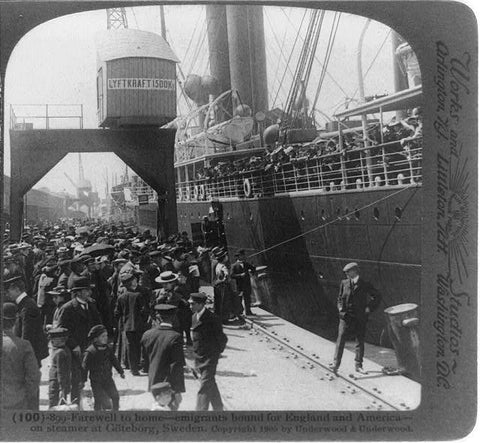Immigrant Experience
The great period for migration from Scandinavia to North America began in 1846 when the cult leader Eric Jansson brought a group of followers to Bishop Hill in Illinois. The period following the Civil War until the start of WWI, saw the movement of about 1.3 million Swedes and 800,000 Norwegians. Significant numbers of Danes and Finns also migrated to North America.

Emigrants bound for England and America, on steamer at Göteborg, Swedem. c.1905. Library of Congress
The push factors motivating these migrants were primarily economic and a desire for religious freedom. The improving health conditions in Scandinavia meant that more children were surviving to adulthood. Although that was good, it brought challenges for those inheriting farmland. The economic situation was not healthy motivating young people to turn to North America where they saw greater opportunity. Furthermore, there was not religious freedom in Scandinavia at the time. The Church of Sweden and Church of Norway were very strict in controlling religious practice. Many pietists and members of other religious groups ran into trouble with the law when practicing their faith. North America offered religious freedom.
The pull factors motivating these migrants included the possibility to acquire farmland in the Midwest in new communities being built along the expanding railroad system. This excellent farm land was essentially taken from Native American tribes and given to the settlers. Migrants typically sailed across the Atlantic to New York City and then continued by train and boat to the Midwest. Some stopped off along the way and contributed to the growth in manufacturing in locations such as Jamestown, NY; Chicago, IL; Minneapolis, MN and beyond. Religious freedom meant that any group could start its own congregation or denomination.
In recent years Scandinavia has seen increase movement of people to Scandinavia. Scandinavian countries (especially Denmark, Sweden, and Norway), have been very open to refugees through their participation with the United Nations High Commission on Refugees. Immigration has not been encouraged until the European Union opened the boarders from immigration from Europe. The recent crisis of refugees from the Middle East, especially Syria, has challenged the well-established social welfare system of the Scandinavian countries. Interestingly, Scandinavians have been critical of the United States regarding discrimination and segregation based on ethnicity. Today, however, as the numbers of Muslim migrants from Africa and the Middle East has increased, popular resistance to migration is feeding the growth of reactionary anti-immigrant political parties throughout Scandinavia.
View our books on the immigrant experience.
 Nordic Studies Press
Nordic Studies Press
